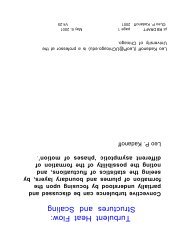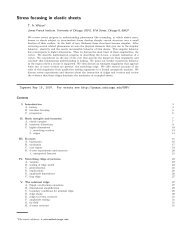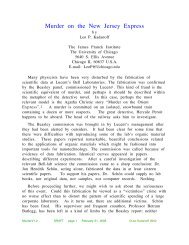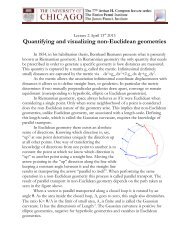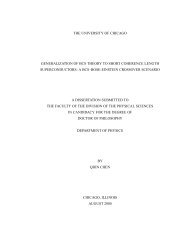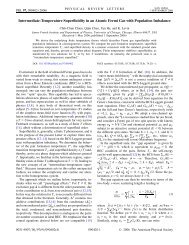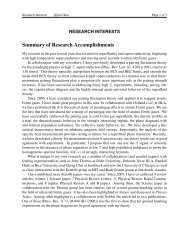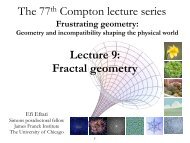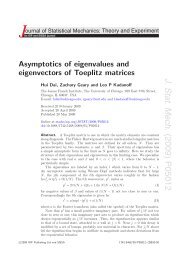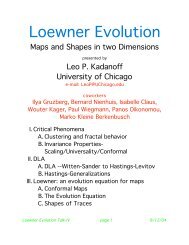Boltzmann's atoms V2.1 page 1 June 20, 2001 ©Leo Kadanoff 2001 ...
Boltzmann's atoms V2.1 page 1 June 20, 2001 ©Leo Kadanoff 2001 ...
Boltzmann's atoms V2.1 page 1 June 20, 2001 ©Leo Kadanoff 2001 ...
You also want an ePaper? Increase the reach of your titles
YUMPU automatically turns print PDFs into web optimized ePapers that Google loves.
Boltzmann’s Atom, The Great Debate that Launched a Revolution in Physics<br />
by<br />
David Lindley<br />
The Free Press, New York, <strong>20</strong>01<br />
History of Science<br />
Viewing Boltzmann: Irony and Achievement<br />
Ludwig Boltzmann (1844-1906) was largely responsible for bringing both<br />
atomic and statistical concepts into the practice of physics. But, as this<br />
scientific biography makes clear, Boltzmann’s triumphs were equivocal, his<br />
message flawed.<br />
Atoms were probably an old idea even to the ancient Greeks. Nonetheless,<br />
a correct analysis of atomic motion could not occur until the mid<br />
nineteenth century, after mechanics had developed concepts of heat and of<br />
energy conservation. Lindley brings us into a scientific world in which<br />
physicists, especially Boltzmann and Maxwell, began to build upon the<br />
existing kinetic theory and to ask whether the observed properties of<br />
gases could be fit into a mechanical view of the world.<br />
The German-speaking universities of his period provided Boltzmann with<br />
opportunities for single-minded focus on <strong>atoms</strong> in motion. Funding raising,<br />
job-seeking, and teaching all provided only limited calls upon his time and<br />
effort. His poor eyesight prevented the development of Boltzmann’s<br />
experimental talents. So he became one of the world’s first theoretical<br />
physicists. In his mind, he built a world of little hard balls bouncing<br />
against one another. Through limitless effort and excellent analytic work,<br />
he developed a mathematical view of the behavior of that world.<br />
Even as late as the 1870s, when Boltzmann was being most creative, there<br />
was hardly any direct experimental evidence for <strong>atoms</strong>. There was<br />
indirect evidence provided, for example, by Dalton’s law of combining<br />
********<br />
Boltzmann’s <strong>atoms</strong> <strong>V2.1</strong> <strong>page</strong> 1 <strong>June</strong> <strong>20</strong>, <strong>20</strong>01<br />
<strong>©Leo</strong> <strong>Kadanoff</strong> <strong>20</strong>01
proportions. Many philosophers of the period found this indirect evidence<br />
to be insufficient. Specifically, Ernst Mach had developed a philosophy of<br />
science which heavily discouraged theorizing by demanding direct<br />
experimental evidence for all scientific concepts. That point of view would<br />
put Boltzmann’s <strong>atoms</strong> outside science. A substantial intellectual collision<br />
took place.<br />
In describing the protagonists’ lines of argument, Lindley develops the<br />
connection with today’s discussions about string theory. This theoretical<br />
approach has been suggested as a possible basis for understanding subsub-atomic<br />
level phenomena. But, strings are not directly observable.<br />
Their study forms a closed world, much beloved by its theoretical creators.<br />
As theoretical interest has moved away from things observable, a previous<br />
cooperation between theory and experiment has much diminished, thereby<br />
making both seem less valid and relevant.<br />
Looking back, Lindley sees that Boltzmann’s work was most radical, not in<br />
its use of <strong>atoms</strong>, but rather in its motion toward statistical concepts. One<br />
cannot construct a fully deterministic theory of many particles in motion.<br />
To treat many-particle systems, one must use a probabilistic approach and<br />
thereby give up elements of accuracy, specificity, and determinism. As<br />
pointed out by Lindley, and previously by Thomas Kuhn, Boltzmann was<br />
extremely reluctant to wed concepts of probability with those of<br />
mechanics. To have explanatory power, he needed to join them. A new,<br />
and very radical, element was needed for his development of the<br />
Boltzmann equation. This element was even more needed for his famous<br />
‘H-theorem’, an attempted mechanical proof that entropy always<br />
increases. While Boltzmann denied and evaded probabilistic arguments,<br />
more subtle and flexible minds saw that a specified and deterministic<br />
mechanics would require entropy to decrease sometimes. Boltzmann’s<br />
research could not be correctly interpreted within the framework he had<br />
brought together.<br />
Something had to give. Neither Boltzmann’s approach nor the second law<br />
of thermodynamics can possibly describe any and every mechanical<br />
system. A more Olympian view is necessary to bring the second law<br />
within physics. One can say that this law is true most of the time, that it is<br />
true ‘on the average’, that it is a property only of ‘likely configurations’.<br />
One can also make ad hoc assumptions of ‘molecular disorder’ as a<br />
supplement to the mechanics of Newton. These choices are possible, but<br />
********<br />
Boltzmann’s <strong>atoms</strong> <strong>V2.1</strong> <strong>page</strong> 2 <strong>June</strong> <strong>20</strong>, <strong>20</strong>01<br />
<strong>©Leo</strong> <strong>Kadanoff</strong> <strong>20</strong>01
ugly. More mathematical and perhaps more elegant formulations are also<br />
available. Boltzmann’s equations are in the most part derivable as a<br />
property of a properly prepared collection of systems. Alternatively his<br />
equations might apply, not to anything real, but to an imaginary,<br />
homogenized broth of infinitely many infinitesimally small <strong>atoms</strong>. I like<br />
the last alternative. It makes statistical physics not a part of finite<br />
mechanics, but a generalization of mechanics to systems with infinite<br />
numbers of degrees of freedom.<br />
Lindley’s careful and thoughtful exposition has brought us to several<br />
ironies. Boltzmann’s straight ahead approach got the equations quite right,<br />
but their meaning quite wrong. Mach was wrong about <strong>atoms</strong>, probably<br />
wrong in demanding that science only include the immediately visible, but<br />
right in demanding a different philosophic outlook for kinetic theory.<br />
Boltzmann was right about <strong>atoms</strong> but utterly wrong in believing that<br />
<strong>atoms</strong> provided a necessary basis for thermodynamics. The second law<br />
does not require <strong>atoms</strong>. Thermodynamics would be equally correct were<br />
the basic constituents in the world <strong>atoms</strong>, or quantum fields, or even<br />
strings. Conversely, nothing in string theory can change the predictions of<br />
thermodynamics or even of the ‘standard model’ of particle phenomena.<br />
Thus we should note with some sadness that any incisive experimental<br />
check of string theory will require techniques and approaches not<br />
presently in view.<br />
Within Boltzmann’s lifetime, Gibbs, Einstein and Planck, aided by deeper<br />
and perhaps more philosophical insights, utterly transformed kinetic<br />
theory once more and thereby developed modern statistical mechanics.<br />
Einstein and Planck constructed the basis for proving the existence of<br />
<strong>atoms</strong> and for undercutting classical mechanics. Correspondingly, under the<br />
influence of modern string theory, maybe the physics of our own day is<br />
also ready to undergo a radical transformation. Some of the fundamental<br />
constants and natural laws and seem to be losing their solidity. ‘Constants<br />
of nature’ are in part being be replaced by ‘running couplings’, varying<br />
with distance and perhaps other environmental elements. The very<br />
structure of our ‘laws of nature’ might be the accidental result of falling<br />
into one among a huge class of possible ‘ground states’. Perhaps we will<br />
soon face a major restructuring of our view of the physical world, even one<br />
comparable to the quantum revolution that started one century ago.<br />
Boltzmann’s great work was accomplished in the 1870s. Scientifically, the<br />
********<br />
Boltzmann’s <strong>atoms</strong> <strong>V2.1</strong> <strong>page</strong> 3 <strong>June</strong> <strong>20</strong>, <strong>20</strong>01<br />
<strong>©Leo</strong> <strong>Kadanoff</strong> <strong>20</strong>01
est was postscript. Toward the turn of the century, Boltzmann moved<br />
away from theoretical physics and began to work on the philosophy of<br />
science. This motion was partially an attempt to defend and discuss the<br />
point of view that he had developed many years before. This attempt was<br />
not successful, and its failure perhaps contributed to his eventual<br />
despondency and suicide.<br />
Leo P. <strong>Kadanoff</strong><br />
Chicago, Illinois<br />
<strong>June</strong> <strong>20</strong>, <strong>20</strong>01<br />
********<br />
Boltzmann’s <strong>atoms</strong> <strong>V2.1</strong> <strong>page</strong> 4 <strong>June</strong> <strong>20</strong>, <strong>20</strong>01<br />
<strong>©Leo</strong> <strong>Kadanoff</strong> <strong>20</strong>01



